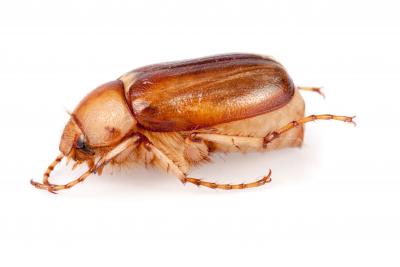It’s not the way I normally like to start a blog but this month I’ve been thinking about cockchafers.
500 years ago, we tried to banish them, but they would not leave,
100 years ago, their numbers were so great we were eating them,
40 years ago, we poisoned them to near extinction, but they survived!
What now?
Cockchafers are much more than a silly name. Commonly seen during Spring, hence their alternate name ‘May bugs’, what is amazing is the fact that when they emerge as adults, they have already existed in our gardens for three to four years. Their grubs have been feeding on our plant roots, slowly rising to the surface, where they will pupate before becoming a rather cumbersome flying creature. The adult will only appear for a few weeks every year but during this time, and if they are sufficient numbers, they can do untold damage to crops. In the latter half of the 20th Century, pesticides were therefore used to eradicate them, but now we know about the harm these chemicals can do to the environment and us!
So, this made me wonder, what is the answer? Do we just shut our doors, lock our windows and barricade our chimneys, or do we go back to turning them into food?
For many, the answer is – yes! Obviously, there is the squeamish aspect but once we have gone beyond that, they could be a very useful addition to our diet. After all, you’d go yuck at woodlice but devour a plate of prawns – and they are very similar creatures.
There are many reasons why insects should be in our diet. More than a billion people already eat insects around the world. In many ways, we are the anomalies and that is only because we have lost the taste for them as our food has become more and more removed from the reality of what it is. As recently as the 1920s, German children were eating sugarcoated cockchafers as a treat but if you asked most German children today, their response would be like ours.
In fact, insects would be a very sensible answer to the problem of feeding the world’s population. They are packed with protein, contain essential amino acids, and are rick in vitamins and minerals. They are also gluten and dairy free, and they haven’t been tainted by concerns over antibiotic and hormone residues (unlike ‘traditional’ meat proteins).
A diet of insects might even be the perfect diet for the health-conscious! If you think this is fanciful because you haven’t seen them in Waitrose, just take a look online! Amazon is already offering protein bars made from insects and high-protein cricket powder. Afterall, as the sales-pitch says: “cricket contains twice as much protein as beef, as much calcium as milk, as much Vitamin B12 as salmon, and 17 amino acids, including Lysine”.
Can this get any better? Well yes, if we consider the environment, farming and food security, then insects must be part of the solution. The current human population is around 7.6 billion, predicted to reach 8.5 billion by 2030 and 9.7 billion by 2050. Set against this, we must also remember that between 2015 and 2017 there was a 35% increase in people facing crisis food levels around the globe – current models for food supply and consumption are basically unsustainable.
Farming insects offers much better returns on our scarce resources – drinking water, animal feed etc. To gain comparable weight, a cow needs ten-times the input of feed as that required by insects. Insects also use far less water than animals, and they require far less space to grow, growing edible tissue more quickly, and multiplying at much quicker rates. Finally, and this may win you over, they produce a lot less harmful emissions than animals like cattle. The methane emissions from cows are considered to be over twenty times more damaging to global warming than carbon dioxide and revised figures indicate that the amount of methane per cow is 11% higher than the United Nations originally estimated.
Insect farming is becoming a ‘thing’ in the West even if you haven’t noticed. Companies, such as Netherlands-based Protix, are investing considerable sums into insect farming as they identify growing markets. At the same time, there is also the opportunity for home farming as they require very little space.
In many ways, we in the West are behind the times. In Cambodia, it’s not uncommon to see poorer families harvesting flying insects at night by using nets and fluorescent lights. These can be delicious with a cold beer! Even in Japan, it is not unknown for bees and bee larvae to be fried and eaten as part of an enkai.
To us, insects are seen as unclean and disgusting but to many they are a sensible source of protein. It’s not such a big step for us to go back to eating them, as was common in our past, and the results would make a big difference for us on a macro and micro level.
For a little bit more on the alternative uses of insects, here’s one I prepared earlier.
